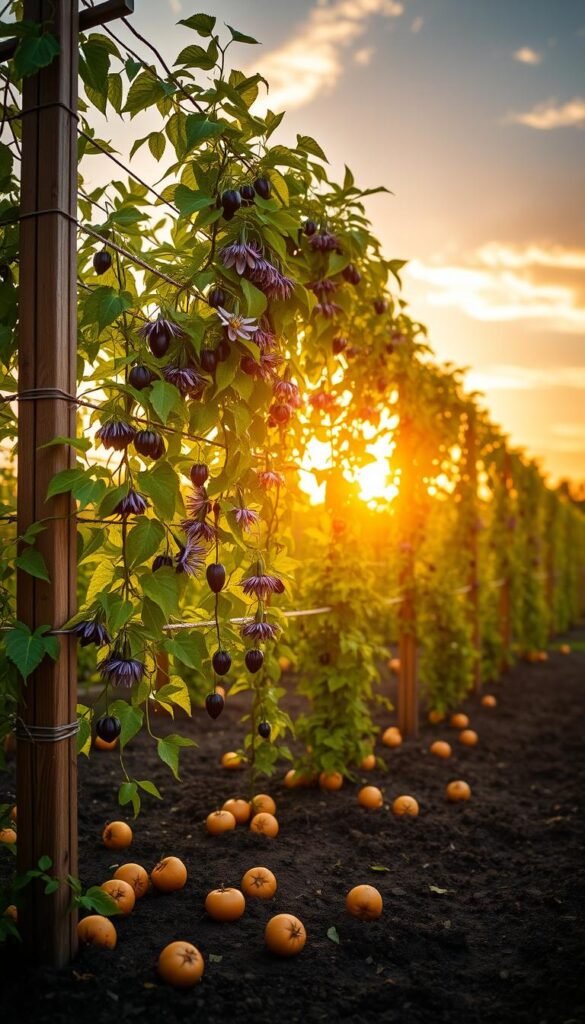Imagine stepping into your backyard and plucking juicy, tropical-flavored passionfruit straight from the vine. These vibrant climbers, native to South America, offer a rewarding challenge for home growers in warmer U.S. regions. With proper care, they transform into lush, productive plants that thrive in Zones 10-12.
These sun-loving vines demand specific conditions to flourish. They prefer temperatures between 68-82°F and struggle with frost or prolonged drought. Cooler climates can still succeed with cold-hardy varieties like Nellie Kelly, while tropical areas benefit from thick-skinned types such as Panama, which resist humidity and pests.
A sturdy support system makes all the difference. Vines grow rapidly, reaching 15-20 feet annually, and require vertical space to maximize yields. Strategic planning ensures healthy growth and easier harvesting—key factors many beginners overlook.
This guide walks you through every step, from selecting the right cultivar to building functional structures that boost productivity. Let’s unlock the secrets to cultivating these exotic gems in your own space.
Choosing the Right Passion Fruit Variety
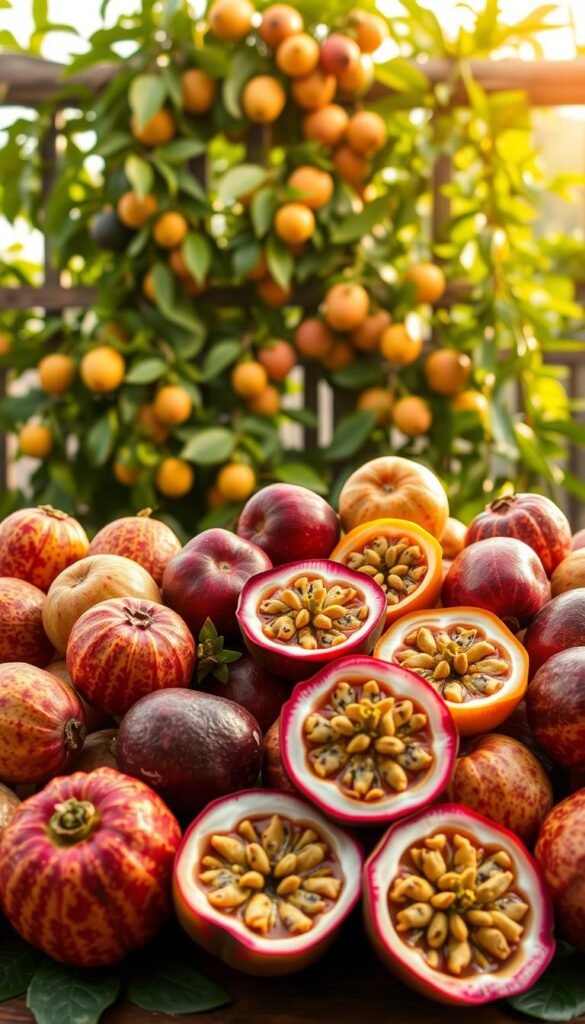
Your journey to a thriving vine starts with smart variety selection. The wrong pick could leave you with sparse blooms or frost-damaged plants, while the right match creates a cascade of fragrant flowers and juicy rewards.
Understanding Local Options
Purple types like Passiflora edulis deliver sweet, lemon-sized fruits perfect for fresh eating. Their yellow cousins (Passiflora edulis flavicarpa) pack tangier, grapefruit-sized punches ideal for juices.
“Match your taste buds and weather patterns – it’s like choosing between citrus and tropical punch flavors!”
Climate-Smart Selection
Cooler zones (USDA 8-9) thrive with purple varieties such as Nellie Kelly, bred to shrug off chilly nights. Tropical gardeners should eye Panama types – their armor-like skins laugh at humidity and bugs. True-to-type seeds let you replicate winners, while hybrids keep you guessing next season.
Consider these factors when choosing:
- Average winter lows in your area
- Rainfall patterns during flowering
- Space available for vine expansion
Preparing Your Planting Area
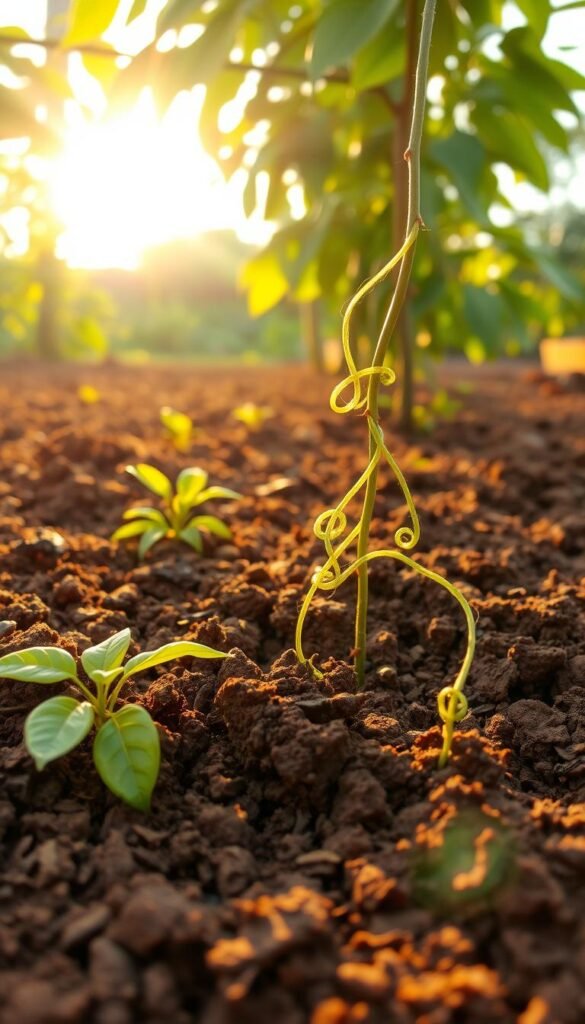
Before the first seed touches the ground, your planting area sets the stage for success. Let’s dig into creating the ideal environment for vigorous growth.
Soil Preparation and Amendments
Start with a soil test—aim for a pH between 5.5 and 6.5. If your ground is heavy clay, mix in 3-4 inches of compost to boost drainage. For sandy soils, add organic matter to retain moisture.
Avoid salty or waterlogged areas. Blend 2 cups kelp meal and 1 cup bone meal into each planting hole. This nutrient cocktail feeds roots while preventing rot.
| Soil Type | Amendment | Benefit |
|---|---|---|
| Clay | Coarse sand + compost | Improves drainage |
| Sandy | Peat moss + manure | Boosts water retention |
| Loamy | Leaf mold | Enhances fertility |
Sunlight and Positioning
Choose spots with 4-6 hours of full sun daily. While vines tolerate partial shade, more light means sweeter fruits. Elevate plants in raised beds if your small backyard has drainage challenges.
Steer clear of frost pockets—cold air sinks into low areas. Space plants 6-10 feet apart for airflow. This prevents mildew and lets roots spread without competition.
Building a Strong Trellis for Your Vines
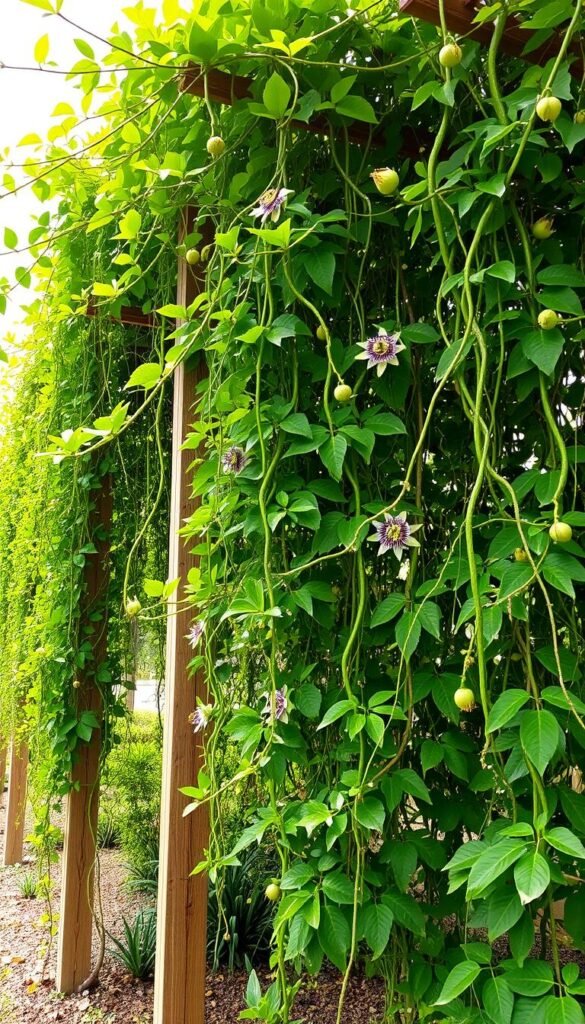
Your trellis isn’t just a structure—it’s a growth accelerator. These fast-growing climbers need rock-solid foundations to reach their full potential. A flimsy setup could collapse under the weight of mature plants, especially when loaded with ripe fruit.
Trellis Materials and Installation
Start with galvanized steel posts cemented 2 feet deep for stability. Space them 10-15 feet apart, adding star pickets between for extra reinforcement. Concrete reinforcing mesh (reo) works wonders as climbing surfaces—its grid pattern lets tendrils grip easily while spreading weight evenly.
Choose weather-resistant materials that won’t rust or warp. Pressure-treated lumber or powder-coated metal lasts longer in humid climates. Secure connections with stainless steel fasteners to handle seasonal shifts without loosening.
Designing for Weight Support
Plan for vertical and horizontal expansion. Mature plants stretch 30-40 feet long and develop thick woody bases. Create a T-shaped design with crossarms to maximize airflow and sunlight penetration. Leave 3-4 feet of clearance beneath for easy harvesting and pest checks.
Test your framework’s strength before planting. Hang 25-30 pounds of weight from various points—if it sags more than an inch, reinforce connections. Remember: Overbuilding now prevents heartache later when those vigorous climbers hit their stride!
Planting Passion Fruit Seeds and Vines

Getting your vines started right begins with smart planting choices. Whether you begin with seeds or young plants, timing and technique determine how quickly you’ll see those first heart-shaped leaves unfurl.
Direct Seeding vs. Transplanting
Starting from seed costs less but requires patience. Soak your seeds overnight in warm water to dissolve their natural gel coating. This simple step cuts germination time by 30% compared to dry planting.
Use small pots filled with loose potting mix for indoor starts. Bury seeds ¼ inch deep and mist daily. Keep containers in a warm spot (70-80°F) with indirect light. Most sprouts emerge within 15 days if kept consistently moist.
Transplant seedlings when they grow 3-4 true leaves. Wait until nighttime temps stay above 50°F—usually 2-3 weeks after your last frost date. Space young plants 8 feet apart to avoid overcrowding as they mature.
- Fresh seeds from ripe fruits germinate faster than stored ones
- Use biodegradable pots to prevent root disturbance
- Harden off seedlings gradually over 7 days before outdoor planting
For direct sowing, wait until soil hits 68°F in early spring. Create 1-foot mounds enriched with compost, planting 3 seeds per mound. Thin to the strongest sprout once established.
Watering and Fertilizing for Lush Growth
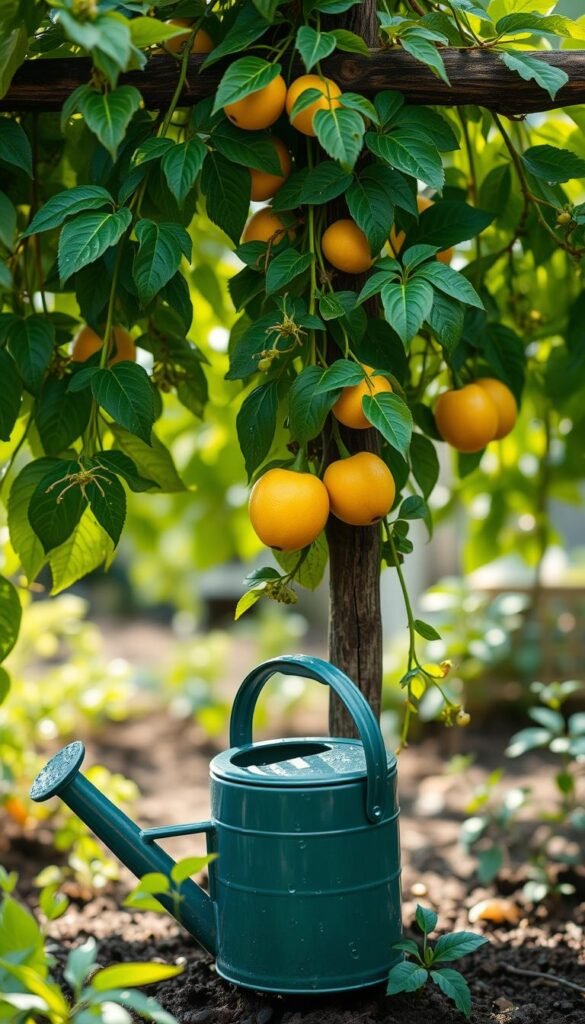
Proper hydration and nutrition turn your vines into fruit-producing powerhouses. Getting this balance right means juicy harvests instead of wilted leaves or stunted plants. Let’s explore how to fuel your vines without drowning their potential.
Irrigation Best Practices
Water deeply 2-3 times weekly during the growing season, letting the top inch of soil dry between sessions. This approach builds drought-resistant roots while preventing root rot. Use drip lines or soaker hoses to deliver moisture directly to the base—overhead sprays invite fungal issues.
Increase frequency when flowers appear. Inconsistent moisture now causes blossoms to drop and fruit to shrivel. Mulch with straw or wood chips to lock in dampness during heat waves.
Fertilizer Application Tips
Feed vines monthly with a 5-5-10 blend once new shoots emerge. Potassium-rich formulas boost flower production and fruit sweetness. Sprinkle granules 6 inches from stems, then water thoroughly.
Skip high-nitrogen options that prioritize leaves over harvests. Organic choices like chicken manure pellets release nutrients slowly. Apply them in early spring as temperatures climb above 60°F.
| Approach | Frequency | Benefit | Risk |
|---|---|---|---|
| Deep watering | 2-3x/week | Strong roots | Dry spells |
| Shallow sprays | Daily | Surface moisture | Root rot |
| Fertilizer 5-5-10 | Monthly | More flowers | Leaf burn |
Pruning Techniques to Boost New Growth
Sharp shears and smart timing transform overgrown tangles into productive plants. Strategic cuts redirect energy to new growth, creating bushier vines with better airflow and sunlight exposure. This practice becomes essential as plants mature, ensuring they don’t become unwieldy jungle messes.
When to Make the Cut
Time your pruning when plants enter dormancy—typically late winter in subtropical zones. Wait until after the last fruit drops but before spring buds swell. Cooler regions should prune after frost risk passes but before active growth resumes.
| Climate Type | Best Pruning Window | Key Action |
|---|---|---|
| Subtropical | Late winter | Cut back to main stems |
| Temperate | Early spring | Remove winter die-off |
| Tropical | Dry season start | Thin overcrowded areas |
Smart Cutting Strategies
Start by removing dead wood and crossing branches. Reduce vigorous shoots by one-third to encourage lateral branching. Use clean, angled cuts just above leaf nodes—this directs growth outward rather than upward.
“Don’t fear heavy pruning—these plants bounce back like champions!”
Focus on three key areas:
- Diseased or insect-damaged stems
- Stems blocking sunlight to lower sections
- Growth extending beyond support structures
Regular trimming keeps vines compact and productive. You’ll notice increased flower clusters and easier harvest access within weeks of proper pruning.
Managing Pests, Diseases, and Environmental Stresses
Protecting your vines requires a watchful eye and smart tactics. While these climbers bring tropical flair to your space, they face threats from hungry critters and environmental challenges. Early intervention keeps minor issues from becoming major headaches.
Guardians of Green Health
Snails and caterpillars top the pest hit list. Copper tape barriers around stems deter slimy invaders, while Bacillus thuringiensis (BT) spray tackles leaf-munching larvae. For underground threats like nematodes, plant marigolds nearby—their roots release natural pest inhibitors.
Fungal foes thrive in damp conditions. Fusarium wilt shows as yellowing leaves and requires immediate fungicide treatment. Improve air circulation by spacing plants properly and trimming dense foliage. Key disease fighters include:
- Copper-based sprays for anthracnose spots
- Raised beds to prevent root rot
- Sterilized tools to avoid spreading viruses
Woodiness virus turns flowers into wrinkled disappointments. Since aphids spread it, introduce ladybugs as natural predators. Remove infected plants immediately—this virus has no cure.
Weather woes demand creative solutions. Drape frost cloth over passionfruit vines when temperatures dip below 40°F. Install windbreaks in gusty areas, and mulch heavily before dry spells. Healthy plants bounce back faster, so make sure your watering and feeding routines stay consistent.
Passion Fruit Garden Success: Trellis Ideas and Growing Techniques
You’ll see results faster than you might expect. Healthy passionfruit vines often produce their first crop within 16-24 months. Subtropical growers might enjoy ripe fruit even sooner. These vigorous climbers reward patience with abundant yields once established.
Plan for the long haul. Most vines thrive for about seven years, but peak harvests typically occur between years two and four. After that, gradual decline is natural. Rotate new plants every 3-4 seasons to maintain productivity and reduce disease risks like woodiness virus.
Refresh your garden by propagating cuttings from healthy specimens. This approach preserves desirable traits while bypassing the seedling phase. Pair this strategy with proper pruning and a sturdy trellis for sustained success. For more expert tips, explore this helpful guide on nurturing productive vines.
With smart timing and care, your space will flourish season after season. Track growth milestones, celebrate each harvest, and keep those delicious rewards coming!
